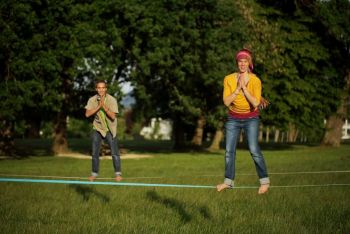
Slacklining entails balancing on a 2.5 to 5 centimetre wide piece of webbing made from synthetic fibres, which is rigged between to fixed points (most commonly trees). Slacklining is an independent sport with many variations and disciplines, championships and professional athletes.
Slacklines are also used as a balance training aid in competitive sports, as fitness equipment or in physiotherapy. The activity also has creative aspects, with a tradition in performances and shows and as a tool for enriching public spaces. Furthermore, it is gaining a foothold in school sports, tourism and as a recreational activity in the public’s free time, which is partly due to slackline parks.
A slackline set basically consists of a piece of webbing (not a rope), two tree slings and a tensioning system – if the slackline is to be rigged between two trees, the set should also include tree protectors.
History

Humans have been balancing on all sorts of things throughout the centuries, mainly on hardly elastic cables, ropes or beams. Climbers also killed their time on rainy days and rest days, balancing on chain barriers in parking lots and the like. Slacklining emerged as an independent activity on stretchy webbing in the early 80ties from said leisure activity of the climbers in Yosemite National Park. Adam Grosowsky and Jeff Ellington were the first to come up with the idea of using their climbing gear to balance on and introduced slacklining to the climber’s camps in the valley. From there it slowly spread into other countries within the climbing scene, and eventually to Switzerland. However, the slackline trend really took off around 2006 in Europe with the introduction of simple slacklining sets in sports shops – We estimate that one in twenty people own a slackline in Switzerland.
How is it different from tightrope walking?

The name “Slackline” says it all, the line is not under a lot of tension. In contrast to steel cables the synthetic webbing is able to stretch under the load of the slackliner on it and becomes dynamic., which makes it necessary to constantly compensate for the movement in the line and would also make it more complicated to walk with an inert balancing pole. While tightrope walking has a long circus tradition, slacklining is a rather young activity. In principle all the tricks shown by performers on the steel cable are also possible on the slackline. As a result of the elastic properties of the webbing, there are also a variety of dynamic tricks that can be pulled off on a slackline. Other differences are that slacklines can be rigged with very little effort and that this sport can easily be practiced barefoot.
Slacklining in Switzerland
Slackline sets became commercially available in Switzerland in 2006. The country has one of the highest concentrations of slackliners together with Austria, Germany and Brazil. Switzerland is home to nine slackline associations with a total of 350 members and dozens of additional Facebook and Whatsapp groups. The oldest association is Slack Attack (Bern, 2009), the youngest are the slackline associations in Vevey and Nyon (2016). All of these associations are part of Swiss Slackline, the Swiss slackline federation. Swiss Slackline, in turn, is a founding member of the International Slackline Association (ISA), which was also founded in Switzerland in 2015. Its vice president, Thomas Buckingham from central Switzerland, is the president of Swiss Slackline at the same time. Festivals such as the Bern City Slack, the Transalp Waterline Tour or the Moléson Highline Meeting have made Switzerland famous in the Slackline universe and attract more international athletes to Switzerland every year.

Swiss top athletes

Even though Switzerland is only a small country with comparatively few active slackliners, it has already brought forth several world-famous athletes. These can be found on our Swiss Team page.
